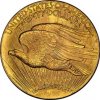
Thanks to a federal jury in Philadelphia, the federal government on Wednesday inched ever so slightly closer to solving its debt crisis.
The reason: a jury found that ten famous $20 gold pieces that would be worth millions on the open market are actually the property of the U.S. Treasury and not the property of the heirs of Israel Switt, a Philadelphia jeweler. Click here for the story from the Philadelphia Inquirer; click here for an earlier story from the WSJ’s Peter Loftus on the case.
According to the Inquirer, after about five hours of deliberation after a seven day trial, the jury said the government proved that when the rare “Double-Eagle” coins ended up in Switt’s hands, they did not get there legitimately. That is, there was no legal way any of the coins could have been removed from the Mint.
“Israel Switt and some of his friends stole 1933 double eagles from the Philadelphia Mint,” Romero said during closing arguments Tuesday.
Barry Berke, the attorney for Switt’s daughter, Joan Langboard and her two sons, Roy and David, declined to comment after the verdict.
Joan Langbord, 81, said on Tuesday that she had “no idea” how her father had obtained the 1933 double-eagle coins. A 1933 double eagle was sold in 2004 for $7.5 million, a record price for any coin.
The family contended they were legally entitled to the coins because there was no way to know exactly how the got out of the mint, and ended up in the Switt family’s safety deposit box.
But Romero said the circumstantial evidence pointed to theft.
The U.S. Mint’s Philadelphia factory made nearly 450,000 of the coins dated 1933. In coin vernacular, which dubs a $10 coin an “Eagle,” they were known as Double Eagles. Etched onto opposing sides of the coins are a soaring eagle and liberty figure resembling a Greek goddess. It was designed by sculptor Augustus Saint-Gaudens in the early 1900s at the behest of President Theodore Roosevelt, who wanted to beautify American coins.
But the 1933 coins were never circulated because a newly inaugurated President Franklin Delano Roosevelt issued an order prohibiting the release of gold from the Mint. It was part of an effort to rescue the banking system, which was endangered by people withdrawing gold at an alarming rate.


